May 28th, 2009
Sphaerocaryum malaccense is one of the newer plants in the hobby that was originally traded erroneously as Arthraxon sp. ‘Malaysia’. Native throughout much of Asia, S. malaccense grows in swampy conditions forming loose mats of vegetation. In the aquarium, it is a very unique aquatic grass with leaves looking like trowels protruding from the stem via a sheath.
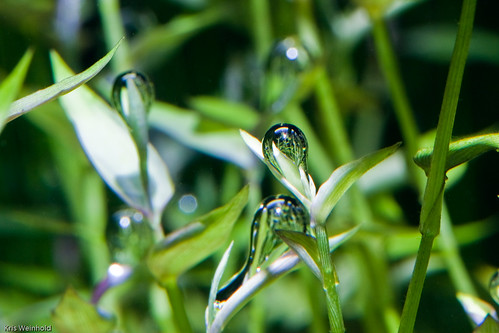
In a large group, Sphaerocaryum malaccense forms a nice bush, but doesn’t seem to form as tight a bush as a plant such as Rotala rotundifolia. It seems to grow well in medium light with CO2, but can really take off in higher light conditions. I’ve seen it grown successfully in some dosing and soil-based tanks, so it should grow in most situations.
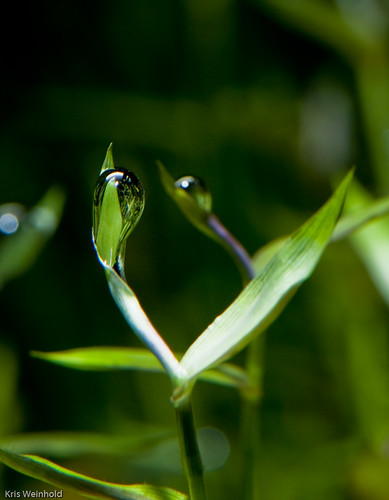
When doing well, my friend Dave has observed that it pearls more than most other plants in his aquarium, with the oxygen bubbles get trapped in the curves of the leaves. Under high light, the leaves can get reddish brown highlights, but some green still remains. Overall, due to the unique aesthetic and relative ease of keeping, Sphaerocaryum malaccense is an exciting new plant to grow and aquascape with.
Posted in Plant Profiles | 4 Comments »
May 7th, 2009
I’ve recently obtained two completely different plants with “Sunset” in their names. The first is Cryptocoryne wendtii var. ‘Florida Sunset,’ which was just introduced last year at the Aquatic Gardener’s Association convention by Florida Aquatic Nurseries (FAN). FAN is the U.S.’s largest supplier of aquatic plants, so you should be able to obtain this plant through your local aquarium retailer.

This variety is named for the extreme varigation present in the leaves. Unfortunately, so far for me, the submersed leaves resemble regular Cryptocoryne wendtii in coloration. In my picture above you can see the varigation in one of the taller, decaying terrestial leaves with green, orange, and red all present.
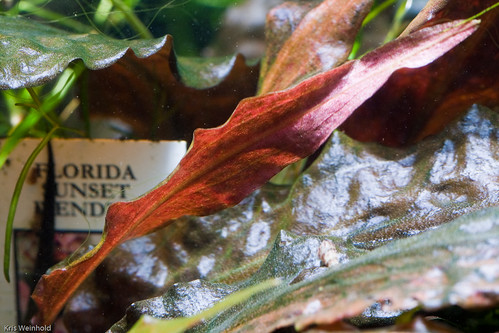
The next plant is known as Rotala sp. ‘Sunset’, and is far more rare in the U.S. Apparently, it’s more readily available in Japan, but I only know that from heresay. This plant is a rather beautiful stem plant exhibiting oblong red leaves with attractive veining, similar to Rotala ramosior. The green stem provides a very nice contrast.

So far it hasn’t been as fast a grower as some other Rotalas, but hasn’t been glacial either. It seems to branch readily, and grows vertically toward to the light. I think it has a lot of potential to be a great aquascaping plant, as a small group could be a fantastic accent plant.
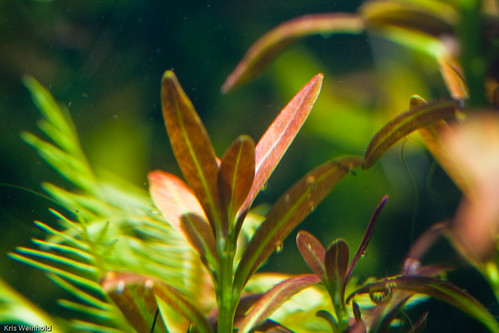
I recommend both of these plants to anyone. Obviously, the Cryptocoryne is more suitable to a wider array of tank conditions, but the Rotala should grow for medium-high light tanks, with CO2 being highly preferred. I have only grown it in high-light with CO2, so I cannot fully vouch for grow in other conditions. If anyone else has kept these plants, please feel free to share your feedback.
Posted in Plant Profiles | Comments Off on Crypt and Rotala Sunset
February 25th, 2009
Elatine americana is a North American native plant found in the eastern half of the United States. It is a fragile looking plant, but bushes readily and has beautiful bright green leaves. Just like other Elatine species, Elatine americana can be aggressively trimmed to stay lower and increase branching. I think it may grow too upright to use as an effective foreground plant, but it is an excellent plant for the mid-ground.
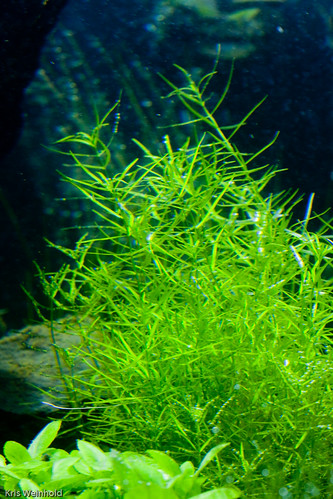
Elatine americana grows in cold weather climates, but I haven’t had any problems growing it in normal tropical temperatures. It grows rather quickly, especially with increased CO2 and fertilizers. I have not tried growing it under low-light or non-CO2 style aquariums, so I cannot speak for it’s suitability in these situations.
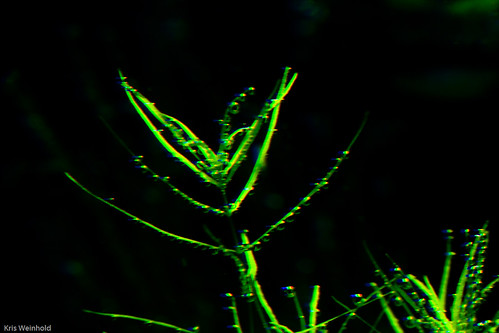
Elatine americana is one of the few new plants in the hobby that has fantastic aquascaping potential. For that reason, I highly recommend it to anyone looking for a fine-leafed midground plant, background plant in nano-tanks.
Posted in Plant Profiles | 3 Comments »
February 10th, 2009
Limnophila repens var. ‘Mini’ is real name for what has been circulating throughout the hobby as simply Limnophila sp. ‘Mini’. It’s a very nice plant submersed, with smaller leaves than L. aromatica with a different coloring, and probably a more vigorous grower. Emersed, the two plants look fairly similar, exhibiting typical leaf shapes and flower forms for Limnophilas.
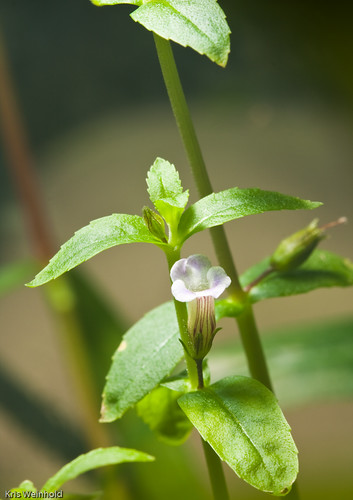
The flower is a nice soft purple color, rising from the stem. As you can see above, flowers can appear at every node. Both submersed and emersed, the leaves have a serrated edge, and a noticably pleasant peppery smell. It is actually kind of a peppery rosemary smell, which is distinctly different from L. aromatica’s scent.

I do have to admit that I did not flower this plant, but I helped a friend from GWAPA take some pictures of these plants. Nevertheless, I’m always excited when aquatic plants flower!
Posted in Plant Profiles | 2 Comments »
January 7th, 2009
Hygrophila sp. ‘Guinea’ is a new plant to the hobby that I’m growing in my 75G aquarium. This particular species of Hygrophila is a larger sized plant, but the leaves are uniquely feathered, so I feel it can be used in spots where other similarly sized plants would be inappropriate. Thus, it should be a very nice plant to soften and break up the common leaf patterns used in many aquascapes.
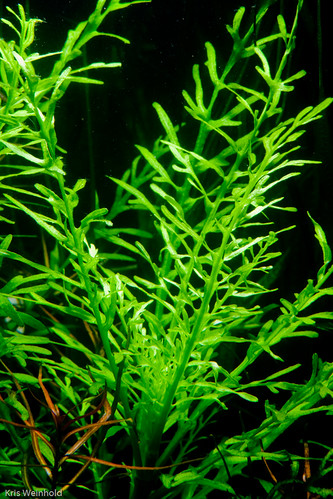
The plant remains a nice bright green color, even under high light and favorable dosing conditions. Hygrophila sp. ‘Guinea’ is a much slower grower than other plants in the Hygrophila genus, which is a good thing in my opinion. The stem is rather thick, and the leaves all appear to point upward from the stem toward the surface.
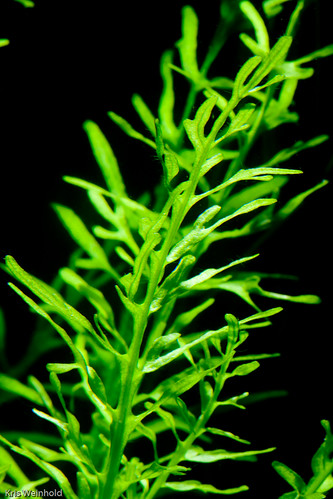
Hygrophila sp. ‘Guinea’ is still quite rare in the U.S., but it is available occasionally through the hobbyist community. If you can find it, it’s a new plant that’s worth trying.
Posted in Plant Profiles | 5 Comments »
December 10th, 2008
I was first introduced to Utricularia gibba at a GWAPA meeting when another member asked the host for a pair of tweezers, and promptly began to remove a few strands from their tank. Utricularia gibba is often mistaken for algae due to its similar appearance, but it is actually a carnivorous plant that survives by trapping tiny microorganisms in its bladders. At least, if you have ever had an algae outbreak, you could take solace that with proper attention, the tank could relatively easily be made algae-free. Unfortunately, if you find Utricularia gibba in your tank, you’re not so fortunate.
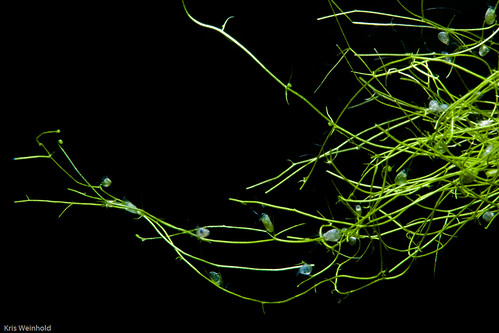
This plant thrives in the same conditions that your other plants do, so your only recourse is to manually remove thread after thread with a pair of tweezers. The most common way that a tank becomes infected is when Utricularia gibba hitch-hikes on some other plant that you introduce into your aquarium.
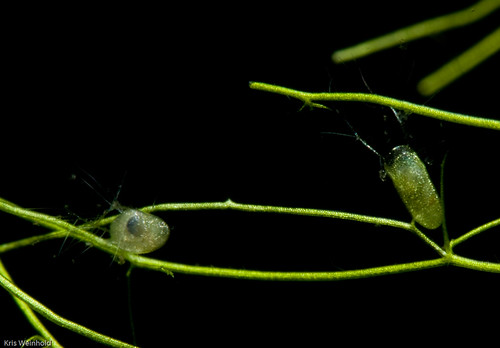
Utricularia gibba Bladders
From there, it’s just a matter of time before the bladder-ridden threads wind themselves in amongst the stems of your beautiful plants. You may actually wish to have this plant in outdoor water gardens, however, as Utricularia gibba does produce a pretty yellow flower above the surface.

Utricularia gibba Bladder
Fortunately, I’ve never had a huge problem with this plant. I’ve introduced it to a couple of my tanks in the past, but luckily was able to contain and rectify the situation shortly thereafter. So, keep an eye out for Utricularia gibba whenever you add new plants to your aquarium.
Posted in Plant Profiles | 13 Comments »
November 24th, 2008
Rotala verticillaris is one of the newer Rotala species entering the hobby from Asia, which coincidentally is also one of the prettiest plants coming in as of late. Believe it or not, but Rotala verticillaris is actually the reference species for the Rotala genus. It’s amazing how diverse this particular group of plants can be when compared to the more common Rotala rotundifolia or some of the other more delicate species. Rotala verticillaris has a thicker stem and branches very tightly, but unlike some others it grows nearly vertical, which make stands of the plant extremely orderly and well positioned.

Also different about Rotala verticillaris is its flower, which resembles something more of a Pogostemon species, than some of the other Rotalas. The flower is, however, quite beautiful exhibiting a striking purple with featherly fronds coming off. Below is a picture of my friend Cavan’s flowering plant.
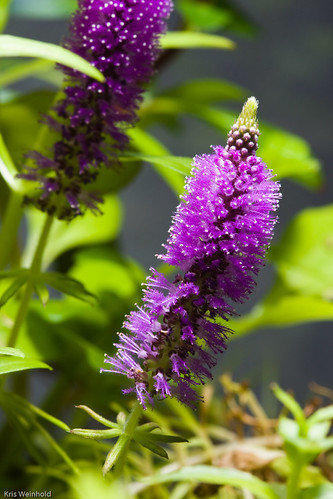
In the aquarium, Rotala verticillaris is not as undemanding as Rotala rotundifolia, as it should require medium/high light plus CO2 injection. Of course, like all plants, it will benefit greatly from a rich substrate and addition fertilization. It is also not as fast a grower as other Rotala species, which in my opinion is a positive thing. I highly recommend this plant for use in any style of aquascape, but it is more perfectly suited to aquascapes with fine leafed and well manicured background stem plants.
Posted in Plant Profiles | 3 Comments »
October 14th, 2008
While at the reservoir last week, I spotted countless stems of Rotala ramosior growing emersed all throughout the dried lake bed. Out in the full sun, the plants were all a deep red color, with many flower buds along their stems. The flowers of Rotala ramosior, often called Tooth-Cup or Lowland Rotala, are small white flowers, that grow in large numbers along the stem.

Within a day or two of putting a few stems in my 40G aquarium, the plants began converting to submersed form, throwing out new green leaves. They also began side-shooting, forming side stems from the main trunk, also with green leaves. The leaves of Rotala ramosior have a very distinct vein down the center of the leaf, from tip to stem. The other veins are not nearly as prominent as the main central one.

Being native to over 90% of the states in the U.S., it’s amazing that Rotala ramosior is not more common in the hobby. It grows well, creates a nice bush like most Rotala species, and is attractive. I’m looking forward to growing it out further, and adding it to my collection.
Posted in Plant Profiles | 2 Comments »
October 1st, 2008
Proserpinaca palustris is a plant that I have long sought after, but only have recently started growing. The funny thing is that it’s actually a native plant where I live, but it’s not a plant that’s often kept by aquarists. The most interesting thing about this medium difficulty plant is the vast difference between its emersed and aquatic forms.

Emersed, the plant exhibits leaves that look a little bit like rosemary, except with serrated edges. Submerged, however, Proserpinaca palustris looks like a totally different plant. The leaves are saw-toothed, being much more ornate than your typical Myriophyllum or Ambulia.

Under intense light, these leaves can actually turn bright red. Proserpinaca palustris should grow under most conditions, but the bottom most leaves will melt away except until moderate light conditions. The advantage I see in Mermaid Weed compared to Ambulia or Myriophyllum is that it grows much slower, while the others tend to overtake your tank. I’m really enjoying this plant, and hope to use it extensively in one of my future aquascapes.
Posted in Plant Profiles | 3 Comments »
September 27th, 2008
Hygrophila difformis var. ‘variegated’ is a new variety of Water Wisteria that grows similarly, but has white veins, giving it a nice variegated look. Just like regular Wisteria, this plant can easily outgrow the space that you allot for it, but if you’re looking for a plant to fill out the corner of your aquascape it might be just what you’re looking for.

One thing to notice is that not all of the leaves exhibit equal variegation. Some contrast quite significantly, while others are hard to differentiate from a regular wisteria leaf. This can occur on leaves along the same stem, even.
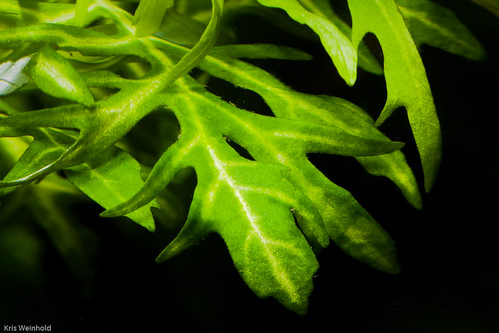
Overall, Hygrophila difformis var. ‘variegated’, it’s a fast grower, a nitrate suck, but most importantly, a pretty plant.
Update: I learned today that this variegation is caused by a virus affecting the chlorophyll in the veins, and can be exemplified by low nitrates. Don’t worry, the virus is self-contained, and causes no danger to this or other plants.
Posted in Plant Profiles | 7 Comments »






















